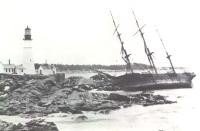 Was the wreck of three-masted bark, Annie C. Maguire, which very conveniently wrecked at Portland Head Light on Christmas Eve 1886, simply an insurance scam? It is said that the ship wrecked so close to the light that the lighthouse keeper Joshua Strout, his son, wife, and volunteers were able to rig an ordinary ladder as a gangplank between the shore and the ledge the ship was heeled against. Captain O’Neil, the ship’s master, his wife, two mates and the nine-man crew crossed the ladder to safety. Thanks to Harry Milkman for passing the story along.
Was the wreck of three-masted bark, Annie C. Maguire, which very conveniently wrecked at Portland Head Light on Christmas Eve 1886, simply an insurance scam? It is said that the ship wrecked so close to the light that the lighthouse keeper Joshua Strout, his son, wife, and volunteers were able to rig an ordinary ladder as a gangplank between the shore and the ledge the ship was heeled against. Captain O’Neil, the ship’s master, his wife, two mates and the nine-man crew crossed the ladder to safety. Thanks to Harry Milkman for passing the story along.
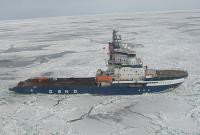 In 2012, Shell’s attempt to drill in the Chukchi Sea in the Alaska’s Arctic proved to be an expensive and dangerous farce, featuring groundings, equipment failures, explosions and citations for safety violations. Returning two years later with an flotilla of 29 ships, Shell’s fortunes have not improved. Rather than discovering oil, the 380-foot icebreaker and supply vessel Fennica discovered an unmarked shoal soon after leaving Dutch Harbor ripping a 39″ gash in her side. The icebreaker, one of two in the flotilla, is being sent to Portland for repairs.
In 2012, Shell’s attempt to drill in the Chukchi Sea in the Alaska’s Arctic proved to be an expensive and dangerous farce, featuring groundings, equipment failures, explosions and citations for safety violations. Returning two years later with an flotilla of 29 ships, Shell’s fortunes have not improved. Rather than discovering oil, the 380-foot icebreaker and supply vessel Fennica discovered an unmarked shoal soon after leaving Dutch Harbor ripping a 39″ gash in her side. The icebreaker, one of two in the flotilla, is being sent to Portland for repairs.
The problem for Shell is that the Finnish-owned Fennica is carrying a capping stack, a vital piece of spill-prevention equipment designed to fit over a damaged well and prevent a blowout. Without the capping stack onsite, Shell may not be allowed to do any deep drilling. As reported by the Seattle Post-Intelligencer:
 Congratulations to Captain Kate McCue. This August, she will take command of the Celebrity Summit, sailing from Bermuda from the East Coast. She will be the first American woman to command a large cruise ship. The Celebrity Summit is a 91,000-ton ship which can carry 2,158 passengers and 952 crew. Captain McCue, 37, previously sailed for Royal Caribbean Lines, Celebrity Cruises parent company. She is a graduate of California Maritime Academy. Thanks to Mai Armstrong on the Working Harbor Committee blog for passing along the news.
Congratulations to Captain Kate McCue. This August, she will take command of the Celebrity Summit, sailing from Bermuda from the East Coast. She will be the first American woman to command a large cruise ship. The Celebrity Summit is a 91,000-ton ship which can carry 2,158 passengers and 952 crew. Captain McCue, 37, previously sailed for Royal Caribbean Lines, Celebrity Cruises parent company. She is a graduate of California Maritime Academy. Thanks to Mai Armstrong on the Working Harbor Committee blog for passing along the news.
In 2010, we posted about Inger Klein Olsen, the first female Cunard captain on the Queen Victoria.
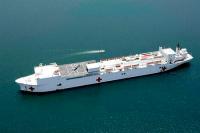
USNS COMFORT
We posted last April that the hospital ship USNS Comfort has deployed on Continuing Promise 2015, a five month mission to eleven nations in Central and South America and the Caribbean. Not all has gone well. On July 9, as reported by the Navy Times, the command senior chief of the medical facility on the hospital ship was fired after allegedly getting drunk and acting up at a reception for the president of Panama, according to a source familiar with the incident. Command Senior Chief Aurelio Ayala was reassigned to Military Sealift Command in Norfolk, Virginia, pending the outcome of the investigation.
Belfast hosted the Tall Ships Belfast 2015 from July 2-5. It sounds like a great success. As reported by the Belfast Telegraph: The fleet of 46 sailing vessels drew record crowds to Belfast, making it one of the biggest events to be staged in the province. During four fabulous days docked in Belfast one ship recorded its highest ever number of visitors. Brazilian vessel, Cisne Branco, had 32,000 visitors on board during its stay in Belfast, the highest number it has recorded anywhere in the world. Thanks to Irwin Bryan for passing along the news.
 A new musical is coming to Broadway this summer, which features a ship’s captain and stage sets with lots of ship’s rigging. It is based on the story of Captain John Newton and the song Amazing Grace. The musical is described: AMAZING GRACE is a new original musical based on the awe-inspiring true story behind the world’s most beloved song. A captivating tale of romance, rebellion and redemption, this radiant production follows one man whose incredible journey ignited a historic wave of change.
A new musical is coming to Broadway this summer, which features a ship’s captain and stage sets with lots of ship’s rigging. It is based on the story of Captain John Newton and the song Amazing Grace. The musical is described: AMAZING GRACE is a new original musical based on the awe-inspiring true story behind the world’s most beloved song. A captivating tale of romance, rebellion and redemption, this radiant production follows one man whose incredible journey ignited a historic wave of change.
The story of Captain Newton and the song Amazing Grace is quite remarkable. The problem is separating the myth from what actually happened.
A beautifully shot drone video of Tall Ships Greenport 2015 from July 6th, featuring the French frigate l‘Hermione; Delaware’s Tall Ship”, Kalmar Nyckel; the Portuguese Navy’s Sagres III; the privateer Lynx; and New Jersey’s Tall Ship, A.J. Meerwald. Thanks to Irwin Bryan for passing it along.
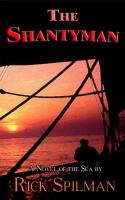 I am very pleased to learn that my latest novel, The Shantyman, is being featured as one of Kirkus’ Indie Books of the Month for August.
I am very pleased to learn that my latest novel, The Shantyman, is being featured as one of Kirkus’ Indie Books of the Month for August.
The Kirkus starred review from last June, called The Shantyman …a fabulously gripping sailor’s yarn. The review also says: With eloquent accuracy, Spilman’s novel captures the life of a 19th-century sailor…. A profound understanding of nautical terminology and procedure is also evident, yet the author is careful not to confuse readers who don’t know a “crojack” from a “spanker.” … Spilman’s colorful, well-researched novel will enthrall both sailing enthusiasts and landlubbers.
This is only marginally nautical, although it does begin and end on a beautiful sailboat. Mostly is it merely silly and yet it is kind of fun. A bit of over-the-top marketing for Johnny Walker Blue, it is a short film starring actors Jude Law and Giancarlo Giannini. And did I mention the beautiful sailboat?
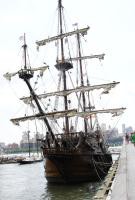 Today I went aboard El Galeon Andalusia, at South Street Seaport. The ship is billed as “a 170 foot, 495 ton, authentic wooden replica of a galleon that was part of Spain’s West Indies fleet.” It is a intriguing ship that has successfully sailed thousands of miles, including crossing the Atlantic. The original galleons, and the carracks that preceded them, were the ships that first girded the globe in 16th and 17th centuries. They changed the vast oceans from barriers to highways. For good and/or ill, these ships literally changed the course of the world’s civilizations.
Today I went aboard El Galeon Andalusia, at South Street Seaport. The ship is billed as “a 170 foot, 495 ton, authentic wooden replica of a galleon that was part of Spain’s West Indies fleet.” It is a intriguing ship that has successfully sailed thousands of miles, including crossing the Atlantic. The original galleons, and the carracks that preceded them, were the ships that first girded the globe in 16th and 17th centuries. They changed the vast oceans from barriers to highways. For good and/or ill, these ships literally changed the course of the world’s civilizations.
The only problem with Galeon Andalusia is that the description “authentic wooden replica” promises a bit too much. The hull is primarily fiberglass, sheathed in wood above the waterline. There is nothing actually wrong with this. Fiberglass is far easier to maintain than a wooden hull. If the description merely becomes “authentic replica” things might be OK.

Katharine The Shark
Recently, sharks and the internet have begun to interact. On the Atlantic coast, shark researchers have been tagging great white sharks, allowing thousands of internet fans to watch their travels across the world’s oceans on the web. On the other side of the globe, the Australian government has given over 300 sharks swimming off Western Australia their own Twitter feeds, in order to help limit fatal shark attacks.
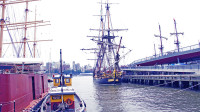
From left to right — masts of the Peking, l’Hermione and the masts of El Galeon
Last week provided a rare opportunity to glimpse over 400 years of sailing ship history in three ships, tied up almost side by side, at New York’s South Street Seaport. Berthed on the south side of Pier 15, El Galeon Andalucia is a replica of a 16th century Spanish galleon. On the north side of the pier was l’Hermione, a replica of an 18th century French Concorde class frigate. On Pier 17, the four-masted barque Peking, built in 1911, represents the culmination of sailing technology, before the world’s commercial sailing fleet was finally pushed aside by steam and motor ships.
What I find fascinating about the three ships is that while their designs are separated by centuries, the DNA of each is easily identifiable in the others. In some respects, the three ships bracket the great European Age of Sail.
On a nearly windless, overcast and rainy morning, the French replica frigate l’Hermione led an impressive flotilla of every sort of craft from very large yachts to jet skis, from below the Verazzano Narrow’s Bridge through the inner harbor and up the North River. Here is a video I shot and edited of the parade. I was a passenger on the lovely schooner Shearwater.
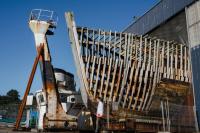
Photo: Dmitry Kostyukov for The New York Times
Last March we posted “Will Prince Albert of Monaco Save Cousteau’s Calypso?” sadly, the answer to the question appears to be, “no.” Earlier in March, following a long legal battle, a French court ruled, that Francine Cousteau, the second wife of the late Jacques Cousteau, owed €273,000 in shipyard bills and was required to remove the RV Calypso from a Brittany shipyard. If she failed to do so the shipyard would be allowed to sell the 43 meter wooden research vessel. Shortly thereafter, rumors began to spread that Prince Albert II of Monaco might rescue the ship and bring it to the Oceanographic Museum of Monaco where Jacques Cousteau served as director for more than three decades, from 1957 to 1988. These rumors appear to have been unfounded. The Calypso has not moved and appears to be in the first stages of being broken up. As reported by the New York Times:
On a hot and hazy afternoon, I stopped by l’Hermione, the replica French frigate docked at Pier 15 at South Street Seaport. A few photographs.
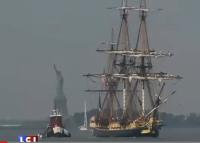 This morning, the replica French frigate l’Hermione arrived in New York harbor and was welcomed by American and French officials, led by French Minister Ségolène Royal and Mayor of Rochefort Hervé Blanché at Pier 15 at the South Street Seaport on the East River. The ship is a replica of the frigate that carried the Marquis de Lafayette to America in 1780 with the news that France was committing to support George Washington and his forces in the revolution against Great Britain. l’Hermione will be open for the public for ship tours tomorrow and Friday, July 2-3, 2015 from 9:00 am – 4:00 pm.
This morning, the replica French frigate l’Hermione arrived in New York harbor and was welcomed by American and French officials, led by French Minister Ségolène Royal and Mayor of Rochefort Hervé Blanché at Pier 15 at the South Street Seaport on the East River. The ship is a replica of the frigate that carried the Marquis de Lafayette to America in 1780 with the news that France was committing to support George Washington and his forces in the revolution against Great Britain. l’Hermione will be open for the public for ship tours tomorrow and Friday, July 2-3, 2015 from 9:00 am – 4:00 pm.
A light-hearted look at who gets to name the new “discovery” by the British sketch comedy team, David Mitchell and Robert Webb.
As reported by Slate Magazine: Scientists have discovered a trippy scene under the Red Sea, full of fluorescent, glowing corals. An international team of researchers discovered the colorful corals at depths of more than 150 feet below the surface and published their findings in PLOS ONE.

Preserved Fish
Puritans were notorious for weird names. Some first names are strangely long, such as “If-Christ-had-not-died-for-thee-thou-hadst-been-damned” or “Fight-the-good-fight-of-faith”. Some names were short but just disturbingly odd. Fly-fornication, for example. In 1766, Preserved Fish was born in Portsmouth, Rhode Island. His first name, Preserved, pronounced “pre-SER-vedd” is thought to be a shortening of “Preserved in Grace” or “Preserved from Sin.”
As a young man, Preserved shipped out on a whaling ship on a voyage to the Pacific. At 21, he became a whaling ship captain. When he came ashore, he became a successful merchant in first New Bedford and then New York City. He founded the shipping firm, Fish & Grinnell. He later became one of the 28 brokers of the New York Exchange Board, which later became the New York Stock Exchange and also became a director of Bank of America. He also served until his death as President of the Tradesman’s Bank. His family, which remained prominent in New York, also gave rise to Hamilton Fish, governor, senator, and secretary of state, and Stuyvesant Fish, a notable railroad president.
Preserved Fish has not entirely been forgotten. Singer/songwriter Ken Ficara immortalizes Preserved Fish with a song by the same name. The lyrics are below. Click here to listen to Ken singing his song.
 The 61′ high 11 ton inflatable Giant Rubber Deck, featured in the Philadelphia-Camden Tall Ships Festival 2015, had some problems in the “Parade of Ships” on Thursday. The duck was being towed on a pontoon, which was found to have holes and was sinking, causing the duck to become unstable. Initial reports said that the duck was undamaged but later accounts suggest that the duck was damaged and leaking and has been taken ashore repairs. With luck, festival-goers will be so involved with incredible fleet of tall ships tied up along the banks of the Delaware River that they will not notice the absence. Thanks to Robert Rustchak of the Philadelphia Ship Preservation Guild and the tall ship Gazela, for passing along his sister-in-law’s photo of the droppy duck.
The 61′ high 11 ton inflatable Giant Rubber Deck, featured in the Philadelphia-Camden Tall Ships Festival 2015, had some problems in the “Parade of Ships” on Thursday. The duck was being towed on a pontoon, which was found to have holes and was sinking, causing the duck to become unstable. Initial reports said that the duck was undamaged but later accounts suggest that the duck was damaged and leaking and has been taken ashore repairs. With luck, festival-goers will be so involved with incredible fleet of tall ships tied up along the banks of the Delaware River that they will not notice the absence. Thanks to Robert Rustchak of the Philadelphia Ship Preservation Guild and the tall ship Gazela, for passing along his sister-in-law’s photo of the droppy duck.
The Philly giant inflatable duck been the subject of some controversy. The Dutch artist Florentijn Hofman who created sculpture named “Spreading Joy Around the World” but universally known simply as “Rubber Duck,” is charging that the Philly duck is an “unauthorized rubber duck project.” Various incarnations of the rubber duck have appeared at over 20 locations around the globe.
